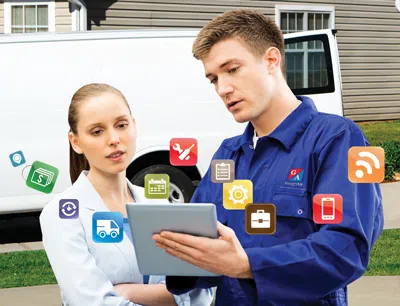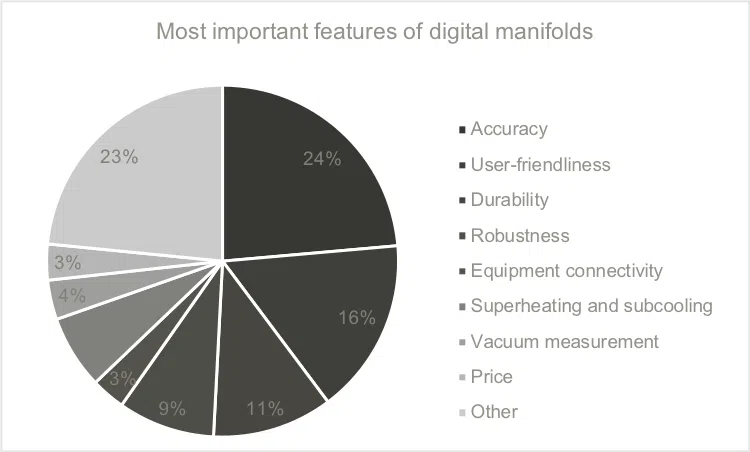Whilst the vision to replace paper in the field is shared amongst many, if not all HVACR organizations, how do we prepare to realize the business case benefits?
It's certainly not all about replacing paper forms and replicating existing processes, and if you find yourself in that line of thought — ring the alarm bells. Most of us have engrained ideas and concepts of an expected outcome based on past experiences. The truth is that you can drive significant profitability across an organization by simplifying the journey ahead, guided by a mobility expert.
A highly configurable mobile application can make for a fast and simple deployment, addressing complex business needs.
Since HVACR technicians spend the majority of their time out in the field, so does use of mobile devices in contrast to office-based counterparts to perform their work. These devices become as natural to handle as any other tool in their vehicle — but each tool has to be fit for purpose.
Mobility for HVACR businesses can enable accurate time tracking, proper part allocation and more rapid service call invoicing. The sales cycles are condensed when customers approve jobs in real-time with digital signatures on each technician's mobile device.
An HVACR organization averaging 72 days from completion of a job in the field to issuing an invoice can reduce this process to 15 days by introducing a mobility solution. This can even be improved to the same day by further reducing any post job processes in back office systems. As a result, a good mobility app can reduce staff-labor hours for data capture by about 30 percent.
Mobile apps are, however, not all about data collection. Making relevant information about the customer, job, reference material and serviced equipment available to the technician increases their productivity. Managers need to assess the necessary information that is to be collated automatically prior to dispatching a work order.
Typically, call center workers spend substantial time chasing technicians for information needed to satisfy customers. Mobility allows for real-time visibility of your field technicians, and as a result, the back office receives direct and instant feedback, which helps monitor and improve customer service. Customer satisfaction can be further improved with timely and customized (brochure-ware style) reports.
Barcode your assets in the field — if they're not already. It's no simple feat, but it's a key factor in increasing productivity of field users. A team of HVACR technicians working at a site with hundreds of assets should be able to walk up to assets, scan the barcode and let the app identify the exact asset with the right service routine to run through.
Having the right information for the right equipment can help your organization ensure a consistent and quality of service being provided, irrespective of the technician attending the service.
Gaining end user adoption should also be a primary focus to ensure business case benefits remain realized post initial deployment. Managers need to know their mobile field users, from their age and technology proficiency to the environment in which each spend most of their day. This understanding drives key considerations for device form selection, a suited user interface design and the right training approach at deployment.
The delivery of your training should match your field users' maturity. Most 25-year-olds learn quickly through a short video whilst others may prefer on hand quick reference guides. A successful model such as train the trainer ensures you have champions (super users) in the field guiding others, long after the initial deployment.
Technicians have a strong habit of communicating amongst each other, so this should always be a focal point before any mobile workforce deployment.
A mobility solution should make the HVACR technicians' life easier at work. A mobile app should ensure easy input of data capture, have intuitive navigation and make use of hardware capability such as GPS. Implementation of simple, quick phrase dropdown selections make it easy for the tech to write descent detail on the service they've performed whilst minimizing keyboard based character entry.
HVACR technicians are typically working in confined areas, so whilst a form may look great on a tablet device — the reality is that only their toolbox and smartphone may make it onto the job site.
For example, you want the tech to be taking a photo of an air handling unit right then and there, straight into the job via mobile. Technicians will leave their mobility solution device in their vehicle if the form factor isn't suited to the environment they work in.
Mobile apps should ensure both flexibility and compliance. Safety and asset service tasking are key compliance areas that should be facilitated by a mobility app, whereas parts, time, and notes by example may be captured in any order based on the situation.
For example, HVACR technicians may need to drop off gas cylinders after a customer's signature at the job site — the mobile app should be flexible to allow the capture of such details to the job — whilst maintaining an audit trail for the customer receiving their service report and charges.
A mobile app has to be effective in the work environment and match expected work process — that is, fit for purpose.
Finally, whilst automation of processes allows an HVACR organization to move to sub-contractors or between subcontractor suppliers, usage of subcontractor suppliers typically exposes you to Bring Your Own Device " BYOD" programs — in which employees use personal smartphones and tablets for business purposes.
In fact, Gartner predicts by 2017, 50 percent of employers will require employees to supply their own device for work purposes. Managers need to consider how the mobility app will be used across such a landscape.
Simplify the journey ahead, consider phased implementation concepts with your mobility expert and focus on gaining end user adoption. This will improve workforce efficiency, customer service and company revenue during implementation and well into the future.
 Alain "Bobby" Manoukian is a project manager for Retriever Communications, a company solely focused on mobility solutions for field operations in the industrial sector. For additional information, vist retrievercommunications.com.
Alain "Bobby" Manoukian is a project manager for Retriever Communications, a company solely focused on mobility solutions for field operations in the industrial sector. For additional information, vist retrievercommunications.com.


 Alain "Bobby" Manoukian is a project manager for Retriever Communications, a company solely focused on mobility solutions for field operations in the industrial sector. For additional information, vist
Alain "Bobby" Manoukian is a project manager for Retriever Communications, a company solely focused on mobility solutions for field operations in the industrial sector. For additional information, vist 

